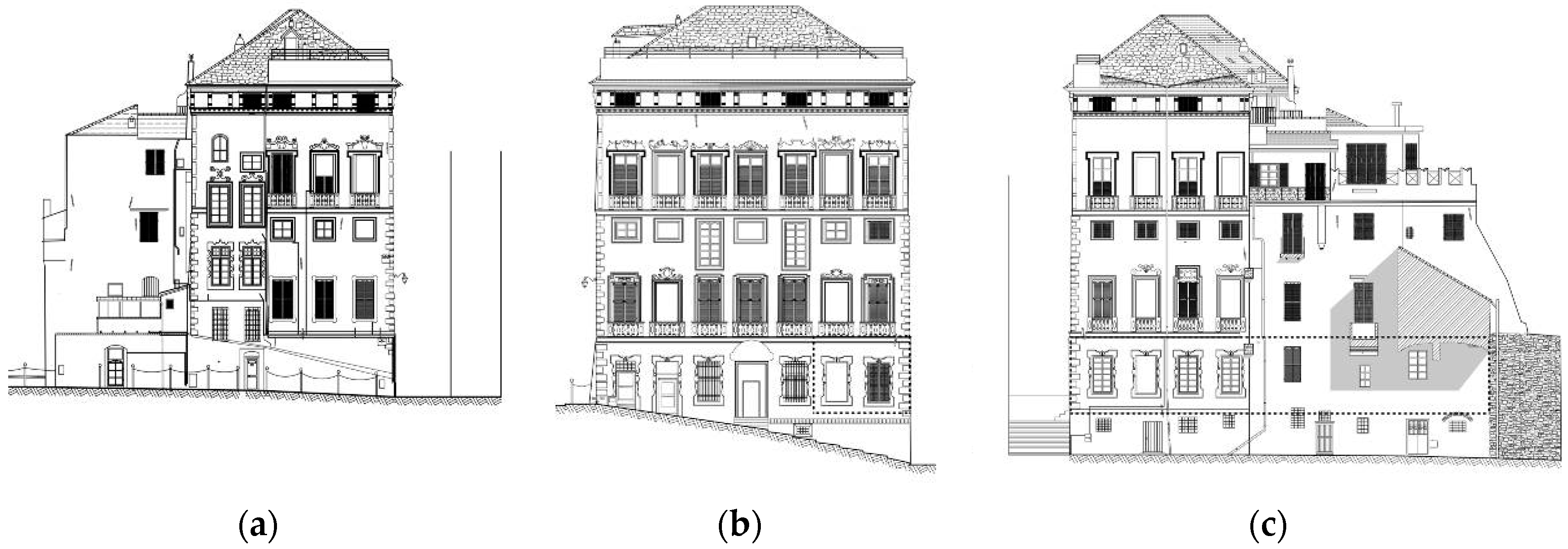Proposal of a Methodological Universal Guide to (Re)discover the Heritage: Palazzo Gastaldi-Lavagna
Abstract
:1. Introduction
Proposal of a Methodological Universal Guide in Carrying out the Process of Renovation of a Historic Building
- The first phase concerns the survey of the building (geometric, material and decorative) to obtain a complete representation of the property in all its dimensional, qualitative and quantitative aspects. The reading of the material degradation and the reading of the deformations and cracks present will also be performed, marking the length, direction, thickness, depth, distribution and frequency.
- The second phase concerns the analysis of the existing archival, historical-architectural, technical-constructive and geological-petrographic types. These investigations on the factory also affect the legal aspects in which one operates with the reading of the constraints that act on the building. The goal is a historical-artistic understanding of the property through the identification of its reasons, its history and its “hic et nunc” in order to protect, recover and enhance the elements and characteristics that make it so.
- The third phase, consequent to the first two, concerns the diagnostic campaign on the factory through in situ and laboratory investigations and tests. These analyses investigate the structural aspects (crack sensors, mono and biaxial inclinometers, sensors for monitoring structural failures and analyses with computer programs) and material ones (stratigraphic analysis, microscope analysis, petrographic analysis on thin sections, X-ray fluorescence, digital microscopy, hygrometric survey and water content determination). The results obtained from this last phase will be necessary knowledge to guide and control the actions of the final phase of the project.
2. Palazzo Gastaldi-Lavagna: Survey and Historical Analysis
2.1. Morphological Interpretation
2.2. Historical Recontruction from Archival Evidence
3. Diagnostic Project
3.1. Stratigraphical Analysis of the Masonry and Plastering
3.2. Diagnostic Investigations on Floor Mortars
3.3. Stratigraphical Analysis of the Wooden Elements
4. Restoration Project
4.1. Conservation Project
4.2. Project of the New
5. Results and Conclusions
Author Contributions
Funding
Conflicts of Interest
References
- Bardeschi, M.D. Restauro: Punto e da Capo, 2nd ed.; Ex fabrica: Milano, Italy, 2010; pp. 281–298. [Google Scholar]
- Grecchi, M. La prima fase del processo. In Ripensare il Costruito, 1st ed.; Grecchi, M., Mailghetti, L.E., Eds.; Maggioli Editore: Milano, Italy, 2008; pp. 13–53. [Google Scholar]
- Torsello, B.P. I militanti. In Che cos’è il Restauro? Nove studiosi a confronto, 6th ed.; Marsilio: Venezia, Italy, 2016; pp. 53–56. [Google Scholar]
- Annoni, A. Restauro, Conservazione, Riuso. In Progettare il Costruito Tra Conoscenza e Interpretazione, 1st ed.; Besana, D., Ed.; Alinea Editrice: Firenze, Italy, 2008; pp. 19–34. [Google Scholar]
- icomos.org. Available online: https://www.icomos.org/charters/structures_e.pdf (accessed on 20 August 2020).
- Morandotti, M. Il rilievo integrale dell’esistente tra diagnostica e progetto. In Diagnostica Per il Progetto di Conservazione. Metodi, Tecniche ed Esempi, 1st ed.; Calvi, G., Morandotti, M., Greco, A., Besana, D., Eds.; Edizioni ETS: Pisa, Italy, 2005; pp. 17–52. [Google Scholar]
- De Moro, G. Porto Maurizio nel Settecento, 1st ed.; Circolo del Parasio: Imperia, Italy, 1977; pp. 20–45. [Google Scholar]
- Ruffini, I.T.C.G. Viaggio tra Storia Arte e Fede. Alla scoperta dei luoghi di culto e dei segni di devozioni di Porto Maurizio e Oneglia, 1st ed.; Grafiche Amadeo: Imperia, Italy, 2003; pp. 58–59. [Google Scholar]
- Sista, A. Una Bottega Artistica del Ponente Ligure nel Settecento: i Carrega di Porto Maurizio (per una storia dell’arte della Liguria Occidentale). Art History Speciality Thesis, University of Genova, Genova, Italy, 2000. [Google Scholar]
- Besana, D. The ecclesiastical complexes: What fate? In [RICH*] Reuse and Improvement of Cultural Heritage, 1st ed.; Aracne Editrice: Roma, Italy, 2017; pp. 185–195. [Google Scholar]
- Ruskin, J. The Seven Lamp of Architecture, 3rd ed.; Dana Estes & Company Publishers: Boston, MA, USA, 1849; p. 113. [Google Scholar]
- Torsello, B.P. La materia del Restauro: Tecniche e Teorie analitiche, 3rd ed.; Marsilio: Venezia, Italy, 1988; pp. 135–146. [Google Scholar]
- ich.unesco.org. Available online: https://ich.unesco.org/doc/src/01851-EN.pdf (accessed on 20 August 2020).
- Atakul, N.; Thaheem, M.J.; De Marco, A. Risk Management for Sustainable Restoration of Immovable Cultural Heritage, Part 1: PRM Framework. J. Cult. Herit. Manag. Sustain. Dev. 2015, 4, 149–165. [Google Scholar] [CrossRef] [Green Version]



















© 2020 by the authors. Licensee MDPI, Basel, Switzerland. This article is an open access article distributed under the terms and conditions of the Creative Commons Attribution (CC BY) license (http://creativecommons.org/licenses/by/4.0/).
Share and Cite
Besana, D.; Chiesa, A. Proposal of a Methodological Universal Guide to (Re)discover the Heritage: Palazzo Gastaldi-Lavagna. Appl. Sci. 2020, 10, 6094. https://doi.org/10.3390/app10176094
Besana D, Chiesa A. Proposal of a Methodological Universal Guide to (Re)discover the Heritage: Palazzo Gastaldi-Lavagna. Applied Sciences. 2020; 10(17):6094. https://doi.org/10.3390/app10176094
Chicago/Turabian StyleBesana, Daniela, and Andrea Chiesa. 2020. "Proposal of a Methodological Universal Guide to (Re)discover the Heritage: Palazzo Gastaldi-Lavagna" Applied Sciences 10, no. 17: 6094. https://doi.org/10.3390/app10176094





